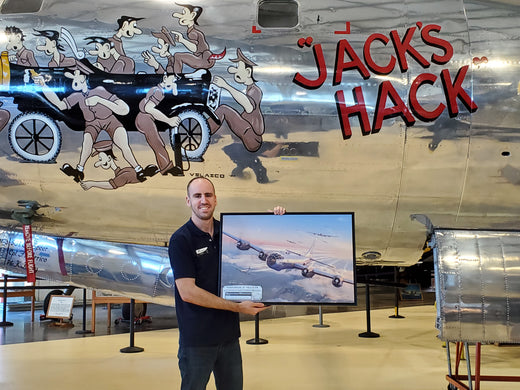This Fine Art Print by Artist Craig Tinder commemorates the crew members of the 58th Bombardment Wing, 20th Air Force and their final mission of World War II. This Limited Edition Canvas Print includes a fragment from an aluminum fuselage panel of a B-29 Superfortress and includes an engraved Certificate of Authenticity.
This art piece was graciously commissioned by the New England Air Museum and includes aluminum from their B-29 Superfortress on permanent display.
Details About the RELIC:
This relic originates from B-29 44-61975 which was accepted in July 1945 and spent its career as a training aircraft. It was recovered from an airplane graveyard by the New England Air Museum in 1973 and was fully restored utilizing the aft fuselage of 44-61739. This fragment of original aluminum was recovered during the restoration, which began in 1998 and took more than ten years. This aircraft is currently on display at the New England Air Museum in East Granby, Connecticut.
 B-29 Superfortress of the New England Air Museum that supplied the material for "Thunderhead of Precision"
B-29 Superfortress of the New England Air Museum that supplied the material for "Thunderhead of Precision"
 Nicholas Hurley - NEAM Museum Curator with "Thunderhead of Precision" print
Nicholas Hurley - NEAM Museum Curator with "Thunderhead of Precision" print
 Artist, Craig Tinder, holding a piece of aluminum from the B-29 44-61975
Artist, Craig Tinder, holding a piece of aluminum from the B-29 44-61975
The Story Behind the Print:
14 August 1945 - Just five days after the second atomic bomb was dropped on Nagasaki, the U.S. Army Air Forces carried out what would be the last conventional bombing mission of World War II. Nearly 200 B-29 Superfortresses from the 58th Bombardment Wing of the 20th Air Force took part in a raid on the Hikari Naval Arsenal, a critical Japanese shipbuilding and armament facility located on the southern coast of Honshu. This mission, codenamed "Thunderhead," was part of an all-out effort to compel Japan's unconditional surrender.
The Hikari Naval Arsenal was a high-priority target for the U.S. military, as it played a vital role in the production and repair of Japanese naval vessels and weaponry. The bombing mission on 14 August was one of the most precise of the entire war, with the B-29 crews successfully delivering their payloads with remarkable accuracy. Notably, no B-29s were lost during the mission, a rare feat given the intensity of previous air operations in the Pacific theater.
The attack on Hikari was part of a broader strategy to continue conventional bombings alongside the use of atomic weapons, pressuring Japan to surrender unconditionally. The mission occurred at a time when Japanese leadership was grappling with the devastating aftermath of the atomic bombings of Hiroshima and Nagasaki, combined with the relentless conventional air assaults on their industrial and military infrastructure.
At noon on 15 August 1945, just a day after the Hikari raid, Emperor Hirohito made a historic radio broadcast announcing Japan’s intention to surrender, effectively bringing World War II to an end. The precision and impact of the final bombing raid underscored the overwhelming power of the Allied air campaign and its role in hastening the conclusion of the war. This mission marked the last major action by the B-29 Superfortress in World War II, an aircraft that had played a critical role in the Pacific theater during the final years of the conflict.
Learn more about Technological Triumph in Aviation in Unveiling the B-29 Superfortress? Click Here
To purchase or see similar items, visit here.
Commissioned by Museums, Treasured by Collectors





Share:
Phantom Ace, the story behind "Tampa Zero One"
Supersonic Legacy, the story behind "Shooting Star"